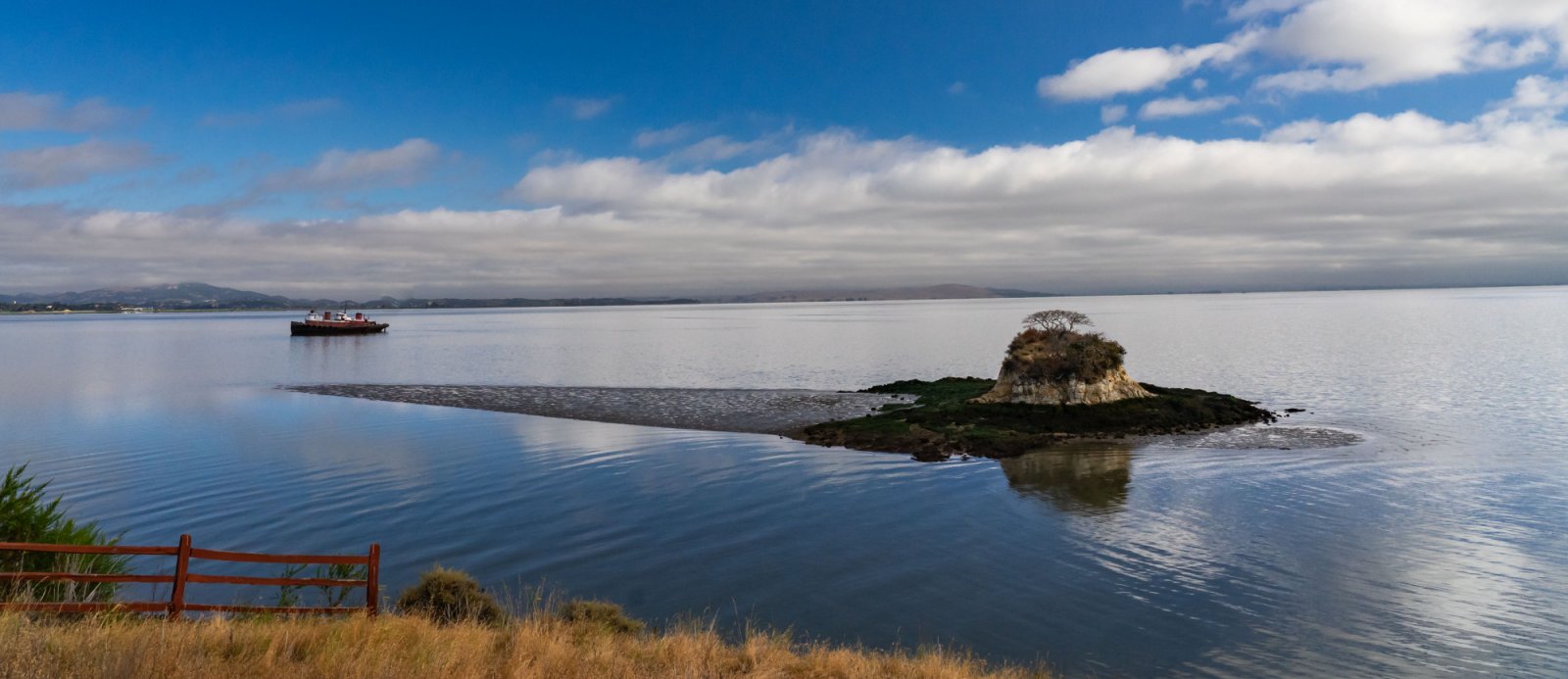
Friends of China Camp News
Winter 2021
Ed Westbrook Receives Special Award
Board Member gets well-deserved praise from Marin organization
By FOCC Executive Director Martin Lowenstein
One of our own received a well-deserved pat on the back this month, when Marin-based Center for Volunteer and Nonprofit Leadership (CVNL) selected Ed Westbrook as the recipient of this year’s Heart of Marin Award for “Excellence in Board Leadership.” The award comes with a $5,000 grant for Friends of China Camp.
Most people connected with Friends of China Camp know Ed as a key member of our volunteer trail crew, where he’s usually happily covered in dust and mud, steering some large piece of equipment. But there’s another side to Ed that deserves recognition: his important role as one of our board members.
FOCC is fortunate to have a strong and diverse board, with each individual bringing a unique set of skills, ideas, and experiences. Ed certainly fits that bill. This year, CVNL honored Ed’s contributions and their positive impact on FOCC. His board work included advocating for the creation of an executive director position and organizing a retreat to revisit the board’s role and envision a future for FOCC. Ed also spearheaded the board’s migration from park operations to governance and fundraising, and he provided the impetus to implement zero-based budgeting for FOCC.
Ed is honored to receive the award and the grant dollars that can go towards FOCC’s park operations.

“The work that I do for the park is joyful labor for me, and I am thankful to all of members of the FOCC team for sharing their talents and time. I truly receive far more than I give.”
China Camp’s 2020 Rock Stars
Trail and maintenance volunteers got the job done
By FOCC Volunteer & Board Member Joyce Abrams
We’re sure it’ll come as no surprise when we say that maintaining a park is one of those things that doesn’t have an endpoint. There is always something that needs to be done. Some tasks are more urgent; some are merely continuous. Regardless, being able to scratch a task off the To-Do list makes our volunteers smile.
Who are these volunteers that have committed thousands of hours to park maintenance? They are people of all ages, backgrounds, and abilities. Many live just over the hill from China Camp; some come from south of San Francisco and the East Bay. One of our regulars comes all the way from Sacramento.
All told, we have about 20 core volunteers who show up almost every week, and another 30 who help intermittently. And we always welcome and encourage new people to join our merry band.
We see ourselves as a team, as family, and as friends—friends who work hard, but add a dose of fun that keeps us coming back week after week. We help each other; we learn; we laugh. We even dress alike: In May, we all got jazzy orange shirts that make us stand out. Not only do they keep us visible to cyclists and drivers, but they also keep us feeling like a team, working towards the same goals of keeping China Camp beautiful and safe for all.

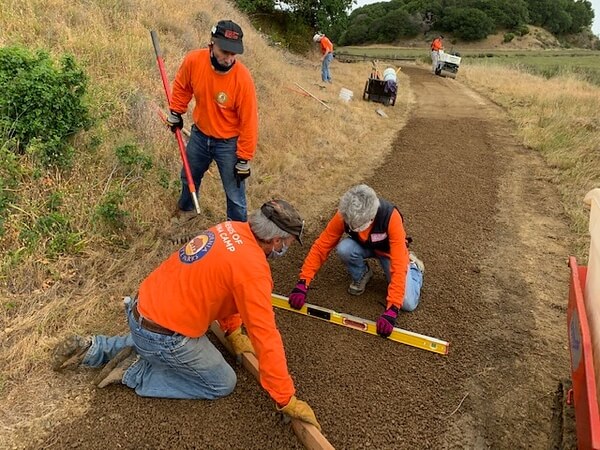
FOCC volunteers work on Turtle Back Nature Trail by Harriot Manley
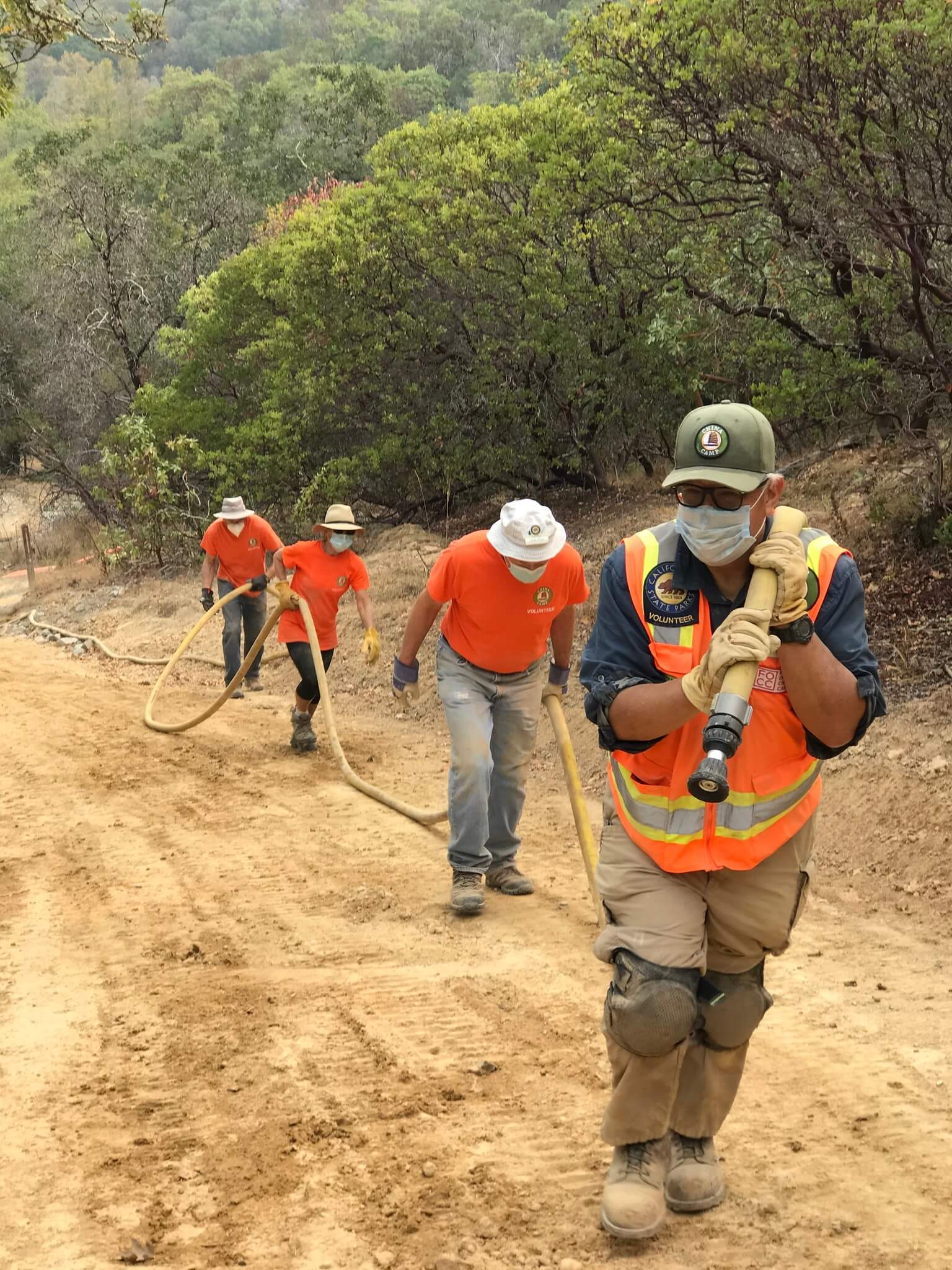
FOCC volunteers lug fire hose to work site at junction of Shoreline Trail and. Back Ranch Fire Road by Harriot Manley
Friends of China Camp volunteers don't know the word stop. Here, they level the surface of revamped Turtle Back Trail, and use heavy equipment lug heavy fire hoses as part of restoration of Shoreline Trail. Images by Harriot Manley
A year of accomplishments
Even though 2020 was a very tough year for everyone, our volunteers hung in there–safely, with masks and distancing–and got the work done. Our biggest success story was the restoration of our ADA-accessible Turtle Back Trail. The work, which took over three months to complete, included moving and spreading 150 tons of special tread gravel for the trail surface. This video tells the tale.
While re-treading Turtle Back Trail was a major accomplishment, smaller but essential tasks kept China Camp volunteers hopping in 2020. Throughout the year, our teams completed these tasks and more:
- picked up trash
- removed invasive plants
- mowed
- weed-whipped
- cleaned bridges
- emptied ash from the fire pits
- groomed trails
- built, repaired, and installed display kiosks
- painted, repaired, and replaced split-rail fencing
- controlled traffic to keep our work crews safe
- carried, used, washed, dried, and rolled fire hoses
- mulched brush
- rebuilt and repaired picnic tables
- washed and painted signs and posts
- split logs for campground firewood
- staked wattles and laid coir mat for erosion control
- installed and cleared culverts
- stayed positive and had fun, even if we couldn’t see each other’s smiles under our face mask
We are exploring a couple of big projects for 2021, including signage repair and/or replacement. We also aim to start identifying illegal trails and restoring damaged habitat. Both projects require research, planning, and fund-raising, and of course it will take volunteers to get the work done once plans and materials are in place.
In the year ahead, we look forward to inviting new volunteers to join us in these and other projects at China Camp. And don’t worry–you don’t need to know how to drive a tractor or build a house to join our band of crazies. In fact, the only skills you need are a can-do attitude and team spirit. And good news–sometimes you get rewarded with donuts, coffee, and popsicles. We can’t wait to meet you—join us now!
Enjoy a photographic year in review of our volunteers at work and play in 2020 at Friends of China Camp’s photo gallery. To enlarge images and access captions, click on the “Play” icon in the top photo’s lower right corner.
Finding Wintering Ducks at China Camp
Where to look for this season’s dabblers and divers
Text and photos by Rich Cimino
With its unique position along the great migration route known as the Pacific Flyway, China Camp makes an outstanding place to look for ducks that spend the winter along the shores of San Pablo Bay.
China Camp’s waterfront bluffs offer an excellent opportunity for even novice birders to scan the water for these fascinating winter visitors.
Unlike some bird species that require you to get up early to look for them in the field, wintering ducks are often visible throughout the day.
Be prepared before you head out. Bring binoculars of 8X or 10X power. (More experienced birders can consider bringing a 60X spotting scope for super close-up views.) Also bring along a good bird guide, like National Geographic Field Guide to the Birds of North America.
More than a dozen species overwinter here
Up to 10 species of diving and dabbling ducks, plus brown pelicans, double-crested cormorants, and two species of mergansers can be seen in the park’s offshore waters. These winter residents rest and feed here after migrating long distances from breeding sites throughout North America. Brown pelicans head here from breeding grounds in Baja California, while China Camp’s diving ducks come from the north.
Once here, San Pablo Bay’s protein-rich waters provide the food that these birds need to restore body fat for insulation. The birds also need energy to molt and grow new feathers for their spring migration back to distant breeding grounds.
Best places to catch the show
From North San Pedro Road, head to the park’s bluffs and picnic points to scan the coves below. Look out across the bay too. Species can include canvasbacks, American wigeons, buffleheads, mallards, Northern shovelers, Northern pintails, ruddy ducks, redheads, and both Barrow’s and common goldeneyes. Also look for scaups, technically two scaup species–lesser scaups and greater scaups–but they’re tough to tell apart so just say “scaup species” if you’re keeping a list.
How can you tell this collection of ducks apart? First, scan the area and note the various sizes of the different species. Next, look for distinguishing features: Do they have long backs or short backs? How long is the neck? Now note the color of the bird’s plumage, then look for specific field marks, such as color on the head or patches of white or green on the wings. Now check the bill shape and color.
Finally, be ready to check the bird from another location, since light and angle can play games with proper identification.
Learn how to ID two wintering ducks
Now we can put this method into play for two of China Camp’s commonly seen wintering ducks.
Let’s start with a male canvasback, pictured at right (less colorful female canvasback to the male’s right). Note that the male is quite large–about 21 inches long–with a good size body and neck. Observe that the large bill is dark and the eye is red. The head is a rich rufous color that drapes down the neck (or nape) to meet a blackish bib across the chest. Giving the bird its name is the distinctive white or pale gray back. Finally, note the bird’s dark, flat tail. Success: you have identified a handsome male canvasback.
Another wintering diving duck with unique features that make it relatively easy to identify is the male ruddy duck, pictured at right. First thing you’ll likely notice is how small it is–just 15 inches long–with a round back. If you could think of some ducks as cute, this one would fall into that category.
Now focus on the head. Look for a large white cheek patch, a dark brown head, and a small gray bill. Like many species of ducks, the ruddy duck has a bill that gets much more colorful in spring, turning pearly blue during breeding season. Finally, notice the distinctively vertical, darkly colored tail.
Congratulations, you have now ID’ed two beautiful diving ducks. Come out to China Camp, find yourself a comfortable spot with a great overlook, scan the water, and see what else you can discover bobbing in the bay.
Author Rich Cimino leads birding trips all over the world, with focus on Alaska, northern California, and Central America. For more information, go to www.yellowbilledtours.com.

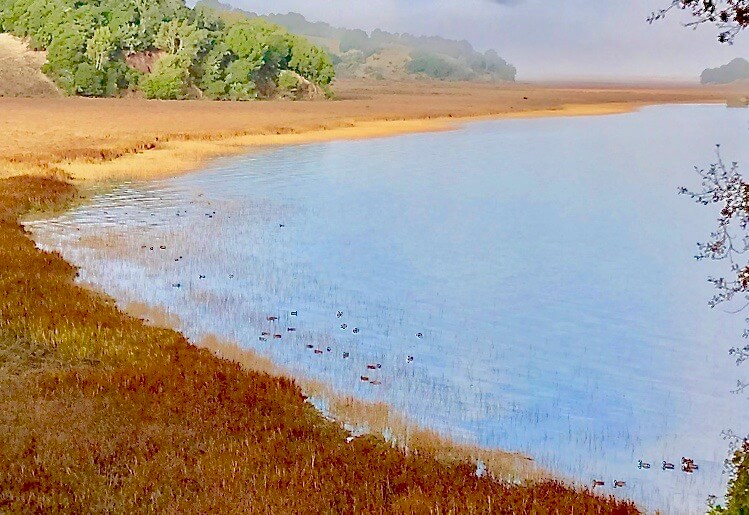

Male and female canvasback, winter tidal marsh, and male ruddy duck by Rick Cimino.
New Mud Buggy To the Rescue
Wish list surprises don’t get much sweeter than this
The good news just keeps coming about China Camp–and so much of it is due to the incredible generosity of our community.
Case in point: Recently, Friends of China Camp was able to purchase a brand-new Toro Tracked Mud Buggy thanks to an anonymous donor. Already it’s proving to be a great asset for our volunteer trail crews.
Mud buggies function like heavy-duty, motorized wheelbarrows with good maneuverability. Until recently, our volunteers had only one of these workhorses available to carry heavy loads of gravel and other materials to trail work sites. That proved to be a bottleneck, limiting how much our crew could get done each day.
Then, a donor came to the rescue. In Friends of China Camp’s Fall 2020 newsletter, we published a Wish List that included a Toro Mud Buggy. In response, an anonymous donor made a gift of stock to fund the purchase, and we quickly added a new mud buggy to our fleet of invaluable equipment. Our profound thanks go to this valued and generous donor.
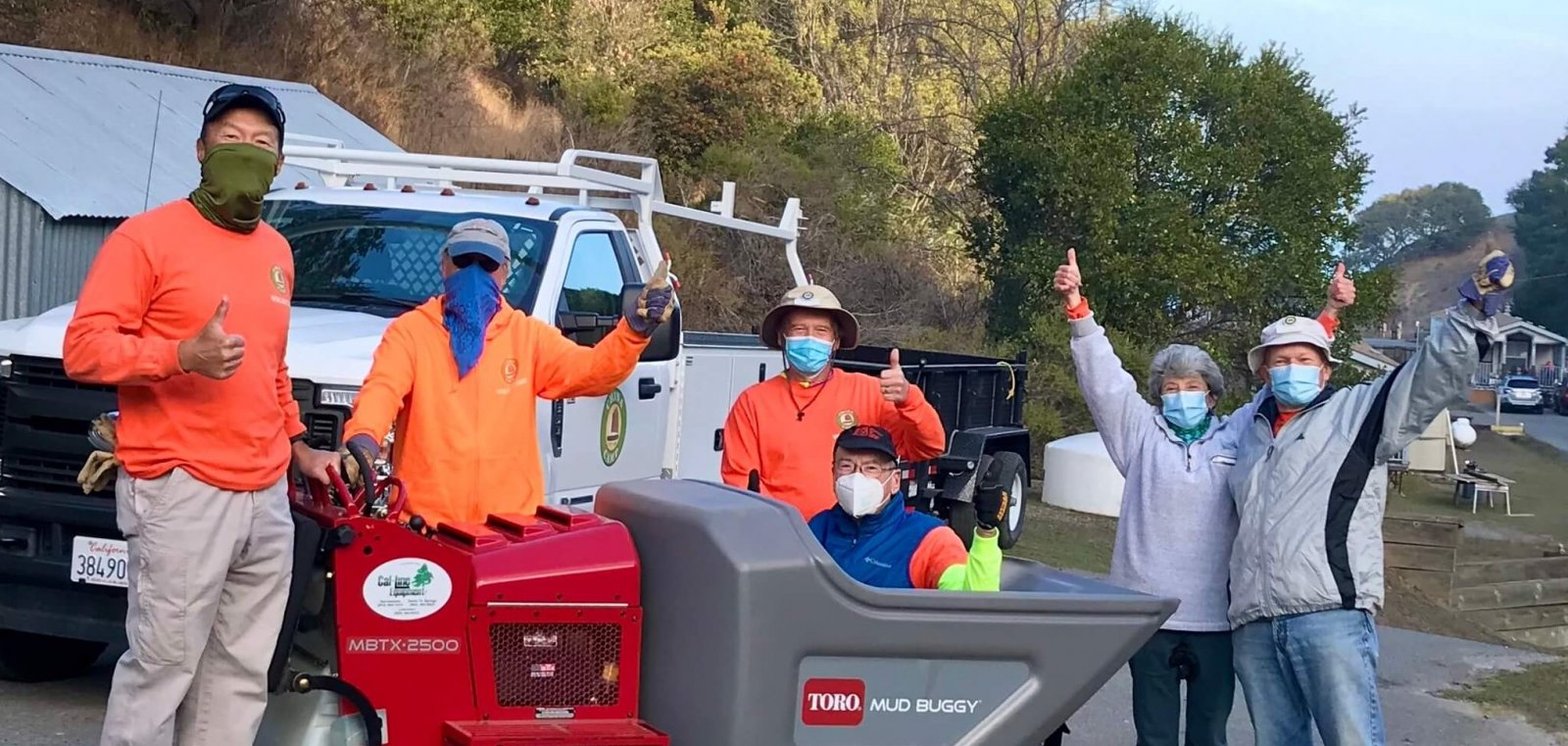
So You Think You Know China Camp?
Test your State Park savvy with our quiz
By FOCC Volunteer Harriot Manley
Since we’re all spending so much time alone these days, we thought we’d cast a net out to our China Camp family of supporters and give you something fun to do, other than figuring out which mask to wear today. We’ve assembled a half-dozen questions to test your knowledge of China Camp State Park. So tug on those cozy wintertime thinking caps, and get guessing. Answers at the end–don’t peek!
1. What is the Grace Quan, and where is she?
A) A dinghy inside the boathouse at China Camp Village.
B) A schooner that sank to the bottom of San Pablo Bay in 1967.
C) A fishing junk at San Francisco Maritime National Historic Park.
D) A rowboat holding produce inside Andy’s Local Market, located at San Rafael’s Loch Lomond Marina.
So You Think You Know China Camp?
Test your State Park savvy with our quiz
By FOCC Volunteer Harriot Manley
Since we’re all spending so much time alone these days, we thought we’d cast a net out to our China Camp family of supporters and give you something fun to do, other than figuring out which mask to wear today. We’ve assembled a half-dozen questions to test your knowledge of China Camp State Park. So tug on those cozy wintertime thinking caps, and get guessing. Answers at the end–don’t peek!
1. What is the Grace Quan, and where is she?
A) A dinghy inside the boathouse at China Camp Village.
B) A schooner that sank to the bottom of San Pablo Bay in 1967.
C) A fishing junk at San Francisco Maritime National Historic Park.
D) A rowboat holding produce inside Andy’s Local Market, located at San Rafael’s Loch Lomond Marina.
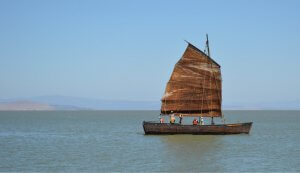
2. How many federally endangered animal species live at China Camp?
A) 3
B) 1
C) 2
D) 5
E) 0
3. What two feature movies were shot at China Camp? (Pick two.)
A) Bridge Over the River Kwai
B) 13 Reasons Why
C) Flipper
D) Blood Alley
E) Gidget Grows Up
F) Hemingway & Gellhorn
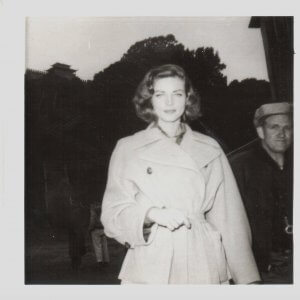
4. What winter phenomenon can make the waters of San Pablo Bay look like they’re boiling?
A) Sturgeon breeding season
B) King tides
C) Annual herring run
D) Wintertime release of methane gas
5. Who was Don Timoteo Murphy?
A) In the 1930s and ’40s, he was a minister who who held regular services at what is now Miwok Meadows group picnic area.
B) The first person to swim the bay following the entire shoreline of China Camp.
C) An Irish immigrant who was mayor of San Rafael in the 1840s.
D) A Latin pop star who, in 2009, filmed a music video on the pier at China Camp Village.
6. What significant event in 2011 could have closed China Camp forever?
A) Gold was discovered by a mountain biker riding across the shallow creek near the Back Ranch Meadows Campground.
B) An irreverent gathering of bohemians and artists, patterned after Burning Man, was secretly held on Jake’s Island, threatening habitat and angering officials.
C) North San Pedro Road, the roadway accessing the park, was discovered to be on the seasonal migratory path of the California newt, a species of concern.
D) Responding to a major budget crisis in 2011, then-Governor Jerry Brown announced permanent closure of 70 California State Parks, including China Camp.
ANSWERS
1: C. Most of the year, this 43-foot replica of a classic Chinese fishing junk is docked at San Francisco’s Hyde Street Pier, along with other historic vessels. The junk, named after the mother of Frank Quan, the last resident shrimper living at China Camp Village, was built by Friends of China Camp Board Member John Muir. He used traditional materials, including redwood, Douglas fir, and bay laurel. For more on this fascinating boat, see our website.
We’ll give you a half-point if you said B. Andy Bachich has a refurbished dinghy named Grace Quan filled with fruits and vegetables inside his eponymous market at the Loch Lomond Marina in San Rafael.
2: A. Two species, the tiny salt-marsh harvest mouse and the secretive California Ridgway’s rail, are well documented endangered species that live at China Camp year-round. But recently a third endangered species, the Northern spotted owl, has been seen in the park’s forested hillsides.
Since these dramatically speckled owls generally live in healthy forests with old-growth characteristics, having the owls hanging out at China Camp is an exciting indicator that our thick stands of oak, bay laurel, and coast redwood are thriving.
3: B, D, and F. The 1955 melodrama, Blood Alley, starring John “The Duke” Wayne and Lauren Bacall (pictured at right), plus many locals as extras, was shot at China Camp. The park was also the site of an opium den in 2012’s Hemingway & Ellhorn, starring Clive Owen and Nicole Kidman. Half a point if you picked 13 Reasons Why, which was a TV miniseries.
4: C. Head to China Camp’s bluffs and picnic points to watch the annual herring run churn up the bay. Typically occurring during the fish’s spawning season of December or January until March, these seasonal gatherings of giant masses of herring attract birds, seals, seal lions, fishermen, and anything else looking for a fishy feast. Look for dive-bombing pelicans and clouds of gulls when the herring start to run, then scan the water with binoculars to watch the surface “boil.”
5: C. Timothy Murphy was an Irish immigrant turned Mexican citizen who, in 1844, was granted the 21,679-acre Rancho San Pedro, Santa Margarita y las Gallinas by the Mexican government. The ranch included much of present-day China Camp State Park and, in 1850, became part of the new State of California. Alas, within three years, “Don Timoteo” had lost most of his once-extensive empire to swindlers, and died of a burst appendix. Visit our website for more on our history.
Interesting aside: North of China Camp is St. Vincent School for Boys, on land deeded by Don Timoteo on his 1853 deathbed. Head to China Camp Point, and, with binoculars, look north along the shoreline to spy the school’s two distinctive towers.
6: D.Governor Brown’s threatened closure due to California’s budget woes in 2011 sparked locals to band together and devise a way to keep China Camp State Park open. With the help of key officials, including then-State Assemblyman (and now U.S. Senator) Jared Huffman (D-San Rafael), closure was averted. In 2012, legislation was enacted that allowed Friends of China Camp to operate and maintain the State Park.
Today, the park almost exclusively relies on Friends of China Camp memberships; trail and parking passes and campsite reservations; other revenue sources; and the incredible work of dedicated volunteers to run the park.
Every dollar helps these volunteers keep the park open and beautiful, and we thank everyone who supports their efforts. Go here for more details on what you can do to help keep China Camp safe and thriving.
100-Ton Gift Delivered To China Camp
Park neighbor makes massive gravel donation
With a true sense of community spirit, The Dutra Group, owner and operator of the San Rafael Rock Quarry just south of China Camp, has made a big donation to Friends of China Camp. And we mean really big.
Recently, Dutra donated 100 tons of special gravel base material. It’s essential for the continued restoration of the tread surface of Shoreline Trail where it loops around our campground.
This in-kind donation is not the first time that Dutra has graciously agreed to FOCC’s request for gravel. It was Dutra’s materials that were used to rebuild a washed-out section of Shoreline Trail in 2017. And FOCC uses materials donated by Dutra for general trail maintenance and for filling potholes in China Camp Village and other locations throughout the park.
“Friends of China Camp relies on partnerships to help operate the park,” notes FOCC Executive Director Martin Lowenstein. “Dutra is a wonderful example of a community partner that invests in China Camp when and where it is needed. I give profound thanks to Aimi Dutra, the company’s Director of Community Relations and Governmental Affairs, and the rest of her team.”


